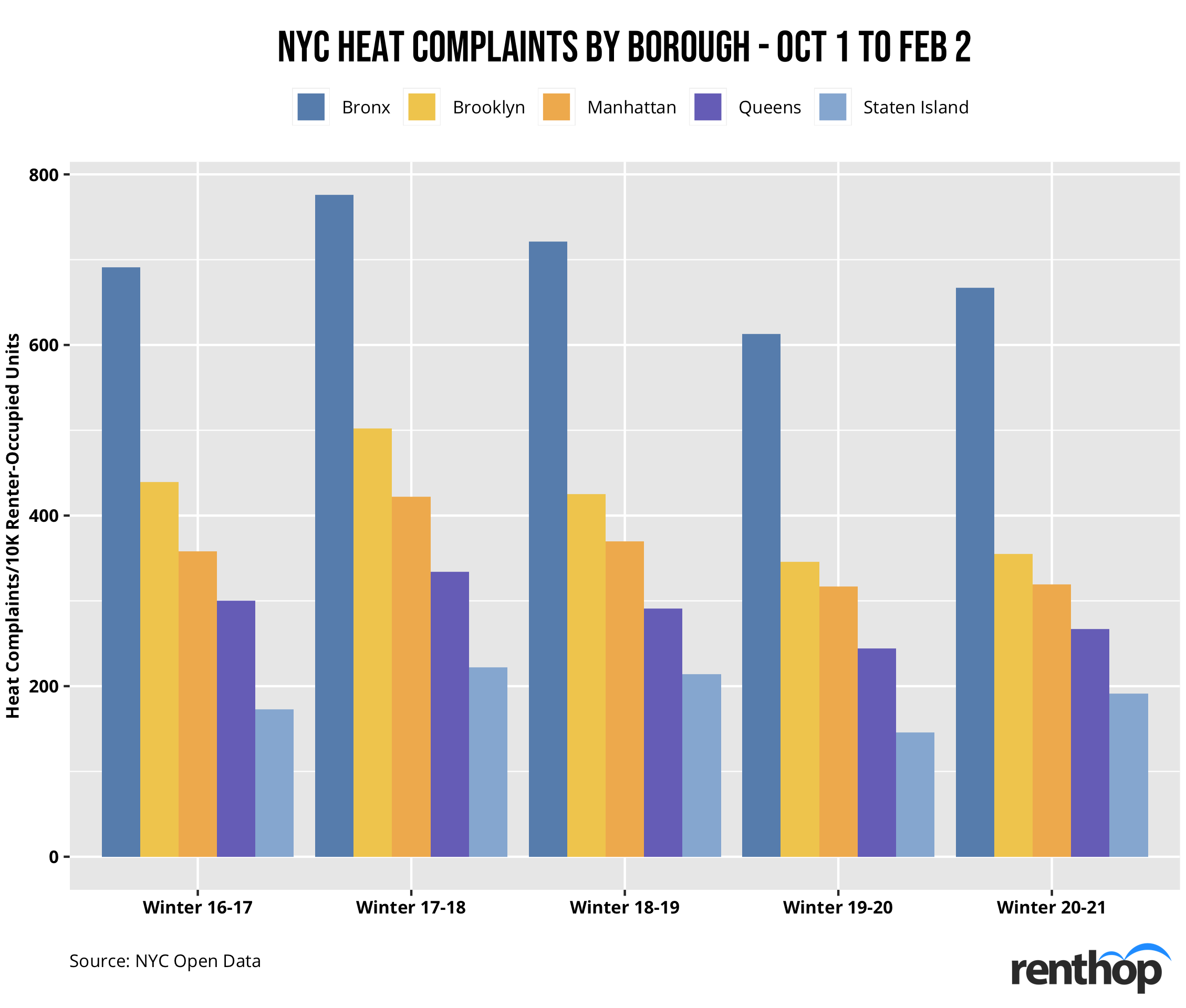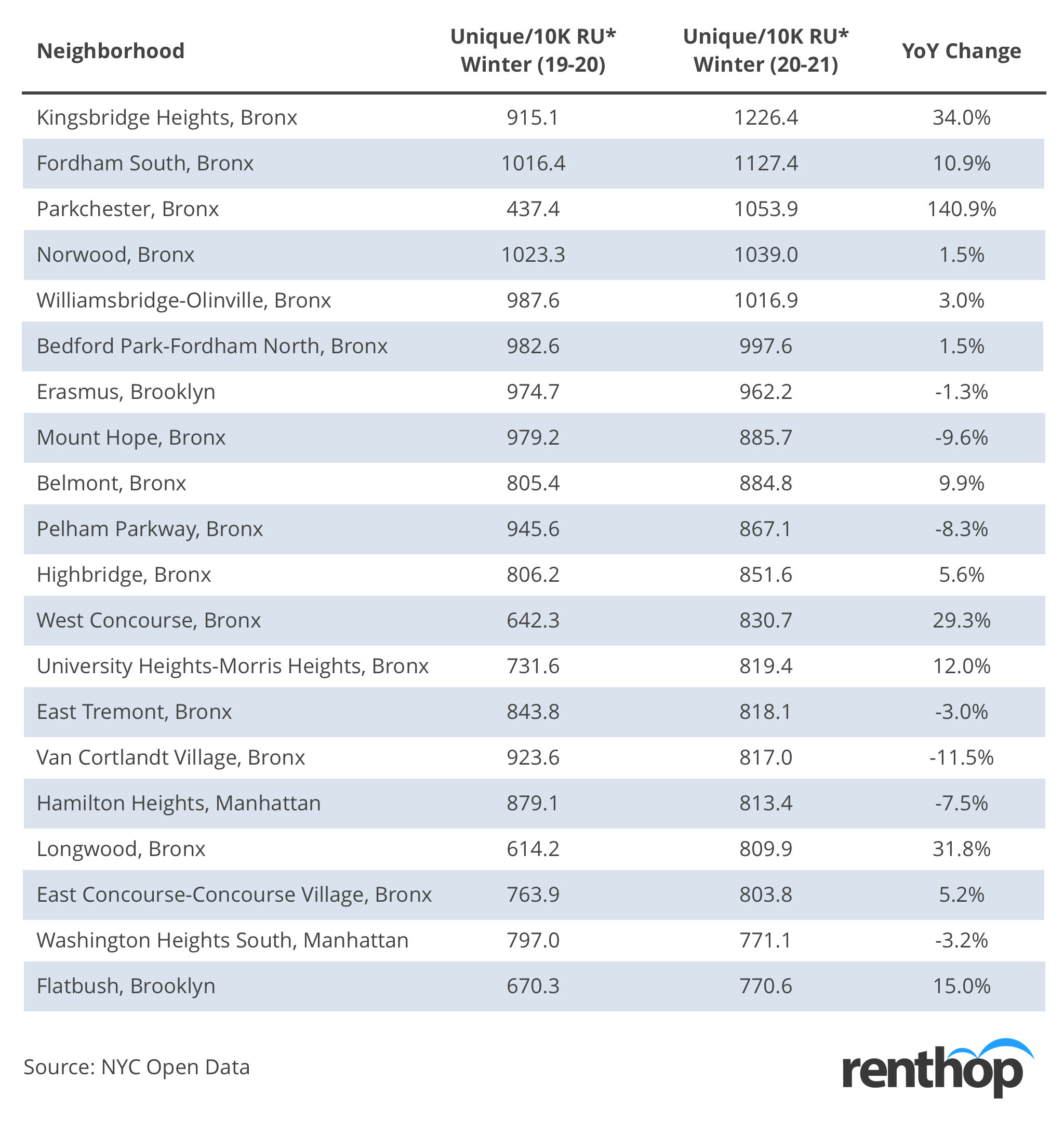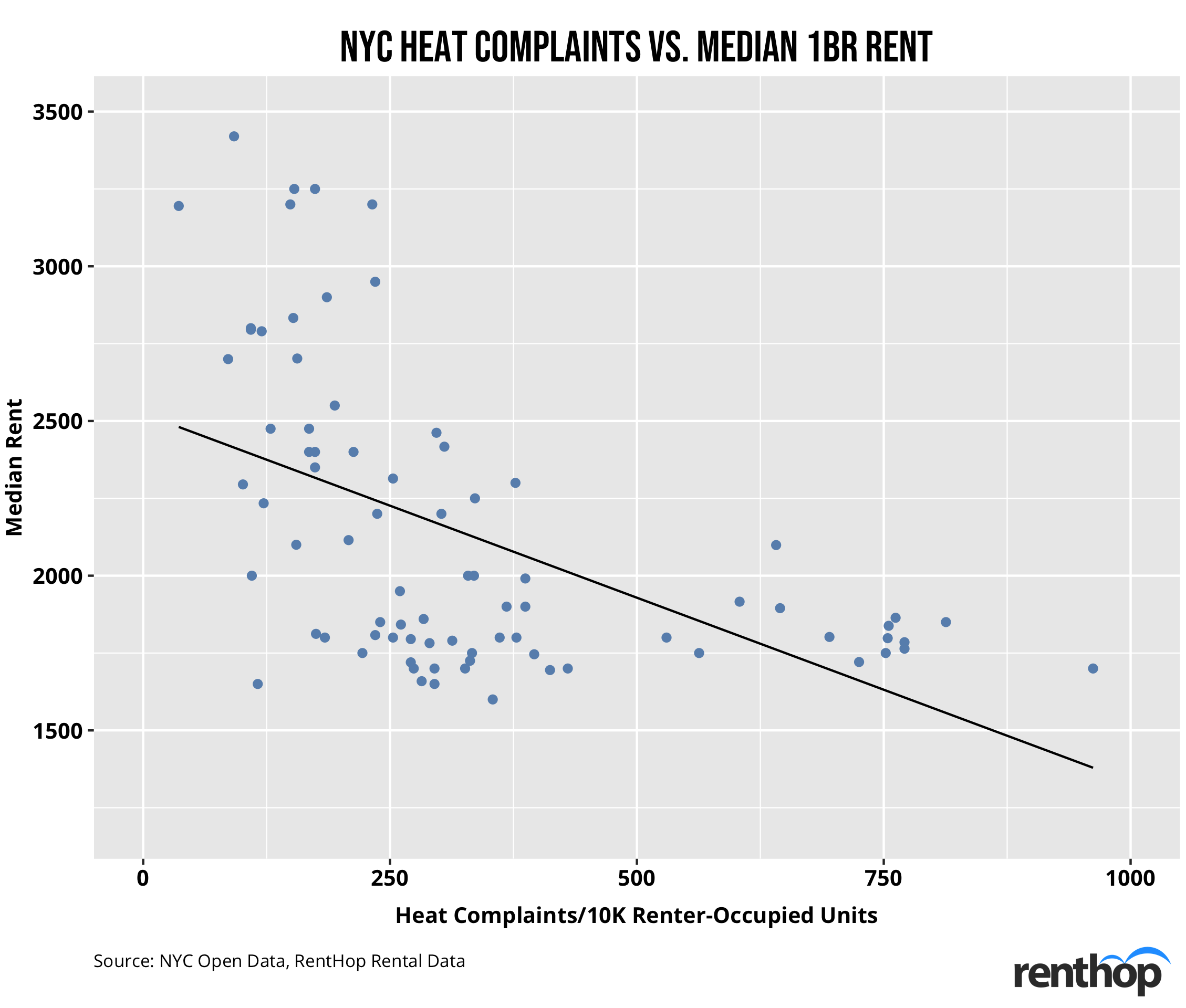As the polar vortex continues to funnel cold Arctic air into New York, New Yorkers brace for another week of wet and snowy weather. While staying warm at home is the only option for most people due to the pandemic, some are not so lucky, especially those who rent apartments in the city.
Although required by the NYC Heat Law, some landlords are too forgetful to turn on the heat, leaving the tenants to face the consequences of their irresponsible actions. Our studies in the past couple of years have shown that certain parts of the city, such as Erasmus (Brooklyn), Norwood (the Bronx), and Hamilton Heights (Manhattan), are just not getting the heat they need, despite people’s complaints to 311. As we brace ourselves for the cold with some hot cocoa, it is time to see which neighborhoods suffer the most this winter.
Key Findings:
- In total, 114102 heat/hot water complaints were filed to 311 by residents in New York between October 1, 2020, and February 2, 2021. After grouping complaints by day and address, we found 82,811 unique heat complaints. This number is 5.4% higher compared to the same period last winter. All boroughs experienced increases in the number of unique heat violations. [Figure 1]
- The Bronx continues to be the worst borough with the greatest number of unique complaints. From October 1, 2020, to February 2, 2021, the borough saw 27,820 unique heat complaints or 667.3 complaints/10k renter-occupied units. Of the top 50 worst neighborhoods with heat violations, 31%, or 62 are located in the Bronx.
- Kingsbridge Heights ranks the worst among over 180 NYC neighborhoods. The neighborhood saw 1,111 unique complaints or 1,226.4 complaints/10k renter-occupied units, 34.0% more than the same period last year. [Figure 2]
- Meanwhile, heat complaints skyrocketed in Parkchester. In total, 1,036 unique complaints have been filed this season, 140.9% higher than last winter.
- Hamilton Heights continued to be the worst neighborhood in Manhattan. From Oct 1 to Feb 2, 2021, the neighborhood saw 1,324 unique heat complaints, 7.4% fewer than the previous winter.
- Our analysis indicates that as rents decreases, the observed incidence of heating violation increases. [Figure 3]
- Some of the worst heat violation offenders include 1713 Harman Street in Queens (276 complaints / 99 unique), 2176 Tiebout Avenue (1,270 complaints / 96 unique) and 2040 Bronxdale Avenue (634 complaints / 93 unique) in the Bronx, and 2305 Bedford Avenue (86 complaints / 84 unique).
When Does the Heat Season Start?
To begin, let us first touch on what the “Heat Season” entails. In New York City, landlords are required to provide heat for all tenants from October 1st through May 31st. While it is indeed a long period of time, the requirements are pretty low:
- Between 6:00 AM and 10:00 PM, if the outside temperature falls below 55 degrees, the inside temperature is required to be at least 68 degrees F
- Between 10:00 PM and 6:00 AM, if the inside temperature is required to be at least 62 degrees F, no outside temperature requirement
Sadly, not every landlord does a good job. Some addresses have been reported hundreds of times since we entered the Heat Season, such as 2176 Tiebout Avenue and 2040 Bronxdale Avenue in the Bronx. Surely, when tenants are suffering, they make dozens of complaints each day to 311. We, therefore, grouped the heat/hot water complaints by address and created date. Complaints filed on the same day regarding the same building are considered one unique complaint. From Oct 1, 2020, the start of this heat season, to Feb 2, 2021, the city received 82,811 unique heat complaints, 5.4% higher than the total unique count of 78,557 in the same period last year.
Mapping the 311 Heat Complaints by NYC Neighborhood
The map below illustrates the “coldness” of each NYC neighborhood. The darker the shade, the more heat complaints per 10,000 renter-occupied units a neighborhood has seen this winter. You can click on the neighborhood to learn more.
As we can tell from the shades, tenants in the Bronx and Brooklyn tend to suffer more than in other boroughs. In fact, when looking at the top 50 neighborhoods with the most unique complaints this year, we discovered that 31 of them, or 62%, are neighborhoods located in the Bronx. Kingsbridge Heights in the Bronx is the coldest neighborhood this winter season in NYC, with 1226.4 unique heat complaints/10k renter-occupied units filed from October 1, 2021, to February 2, 2021. Meanwhile, things got worse in Parkchester, the Bronx this year. The neighborhood, ranked 48 last year during the same period, ranks third this year, with 1053.9 unique complaints/10k renter-occupied units filed.
Figure 1 below further summarizes the number of normalized heat complaints by borough between October 1 and Feb 2 from 2016 to 2021. We can see that the Bronx has historically been the worst borough when it comes to heat complaints, 77.4% worse than Brooklyn last heat season, and 88% worse this year. It is worth noting, however, that all five boroughs saw an increase in the number of unique complaints this year. Renters in Queens have filed 9.5% more unique heat/hot water complaints this winter season as of Feb 2.

Figure 1
These are the Coldest Neighborhoods in NYC

Figure 2
The Higher the Rent, the Warmer the Room
In addition to the geographical locations of the heat complaints and proximity to the city center, we also took the time to explore the relationship between rental rates and heat complaints.
In order to assess the correlation between median 1-bedroom rent and incidence of a heat/hot water complaint, we plotted the two against one another and calculated the correlation coefficient. We found that there is a negative correlation (-0.525) between median 1-bedroom rent and the number of heat complaints/10k renter-occupied units. In other words, as rents increase, the observed incidence of heating violation decreases. To a certain degree, this is not surprising, as landlords charging higher rents tend to have more resources and staffers on their management team.

Figure 3
Beware if You Are Looking to Rent in One of these Buildings
In addition to breaking down the heat complaints by their respective neighborhoods, we thought we’d also take a look at how many times each address has been reported this winter. Don’t want to spend any cold days calling 311 and freezing at home? Be sure to check out these repeat offenders before signing your lease! You can further explore the data by sorting the data by column or doing a quick search using the search bar.
Full Dataset
The interactive table below summarizes all New York City neighborhoods (excluding parks and cemeteries) and the number of heat violations filed between October 1 and February 2. We further ranked the neighborhoods by normalized heat complaints.
Methodology
For this study, we looked at all 311 Heat/Hot Water Complaints released by the NYC OpenData Portal. We limited the scope to only complaints created between October 1 and February 2, as this allowed us to properly compare each neighborhood, borough, and address year over year. Of course, some tenants struggling with cold weather might create multiple complaints within a day. De-duping helps minimize the effect of potentially malicious or very angry residents. We achieved so by grouping together same-day complaints from the same address.
To fairly rank the neighborhoods, we further normalize the data by dividing the number of heat complaints by the number of renter-occupied units in a neighborhood retrieved via the American Community Survey (people owning their home and are cold should settle that dispute with their significant other). The number used when ranking neighborhoods and comparing to median rents represent unique complaints per 10,000 renter-occupied units (RU) in a neighborhood.
Median 1BR rents used in the analysis were compiled via one-bedroom rental listings created on RentHop between October 1, 2020, and February 2, 2021. Only neighborhoods with over 20 unique listings were included in the regression analysis.




